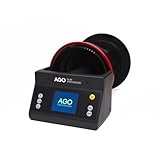When it comes to achieving stunning results in film development, choosing the right rotary film processor can make all the difference. You want efficiency, precision, and consistency in your workflow. The Arista Freestyle AGO Film Processor and the Professional Slide Film Cutter stand out for their unique features. But what about the other factors that play a significant role in your decision? Let’s explore these top options and what they can do for your film development process.
Arista Freestyle AGO Film Processor with 2x Reel Paterson Tank
If you’re a photography enthusiast looking to streamline your film development process, the Arista Freestyle AGO Film Processor with 2x Reel Paterson Tank is an excellent choice. Weighing just 2.75 pounds, it’s user-friendly and compatible with various film formats like 35mm and 120. Its automated agitation saves time and reduces chemical waste by up to 60%. Plus, the intelligent system monitors temperature, ensuring consistent results every time. With preprogrammed processes, you can customize your development while the advanced algorithms simplify your workflow. This processor truly enhances efficiency, making it a top contender in darkroom film processing equipment.
Best For: Photography enthusiasts and professionals looking for an efficient and user-friendly film development solution.
Pros:
- Automated agitation ensures consistent film development while saving time and reducing human error.
- Compatible with various film formats, including 35mm, Medium Format (120), and larger sizes up to 8×10.
- Intelligent temperature monitoring system allows for precise control, enhancing reliability in processing.
Cons:
- Initial setup and learning curve may be challenging for beginners unfamiliar with film processing.
- Limited to specific film processes (C-41 and E-6), which may not accommodate all types of film.
- The compact dimensions might limit the size of tanks and reels that can be used effectively.
Professional Slide Film Cutter for 35MM & 120 Medium-Format Negatives
The Professional Slide Film Cutter for 35MM & 120 Medium-Format Negatives is an essential tool for photographers seeking precision and efficiency in film processing. Weighing just 7.8 ounces, its compact design makes it easy to handle. The built-in adjustable backlight illuminates your work, providing clear visibility for accurate cuts. With an anti-slip silicone pad, it stabilizes your film, preventing scratches. Users praise its sharp blade and ease of use—just align the film and slide for neat cuts. It enhances your film digitizing process and boasts a solid average rating of 4.4 stars, making it a reliable choice for any photographer.
Best For: Photographers and film enthusiasts who require precise and efficient cutting of 35MM and 120 medium-format negatives.
Pros:
- Built-in adjustable backlight for enhanced visibility during cutting.
- Anti-slip silicone pads ensure stability and prevent scratches on film.
- Compact and lightweight design makes it easy to handle and store.
Cons:
- Some users report screen lines that can obstruct visibility.
- Not suitable for those who prefer using scissors for film cutting.
- Limited warranty information available upon request.
Self-Healing Clear Paint Protection Film Kit for Cars
For car enthusiasts seeking to protect their vehicle’s exterior, the Self-Healing Clear Paint Protection Film Kit offers an ideal solution. This high-quality, virtually invisible urethane film is 8 mm thick and shields against chips, abrasion, and weathering. The kit includes computer-cut pieces tailored to your specific car, along with instructional videos and installation tools. While installation may take about six hours, it’s recommended for those with some experience. Afterward, wait 24 hours before washing your car. With proper care, including the use of wax and avoiding abrasive polishes, this film will keep your car looking stunning for years.
Best For: Car enthusiasts and owners looking to protect their vehicle’s exterior from damage while maintaining its aesthetic appeal.
Pros:
- High-quality, self-healing film that effectively protects against chips, abrasion, and weathering.
- Custom-fit pieces tailored to specific vehicle models for seamless installation and appearance.
- Positive customer service experiences noted for resolving issues and assisting with installation challenges.
Cons:
- Installation can be challenging and may require experience, which could deter some users.
- Mixed reviews on ease of installation indicate that patience and skill are necessary for best results.
- Limited customer ratings (3.5 out of 5 stars) suggest that not all users may be satisfied with the product.
Factors to Consider When Choosing Rotary Film Processors
When choosing a rotary film processor, you’ll want to take into account factors like development efficiency and compatibility with different film formats. It’s also essential to look for user-friendly operation and effective chemical conservation techniques. Finally, reflect on the agitation methods available to guarantee ideal results.
Development Efficiency Features
Choosing the right rotary film processor hinges on understanding its development efficiency features, which can greatly impact your workflow. Look for automated agitation, as it saves time and guarantees consistent film development while minimizing human error. With rotational agitation, you can enjoy chemical savings of 14% to 60%, making the C-41 and E-6 processes more economical.
Temperature flexibility is another key feature; processors that allow adjustments between 86 to 100.4°F (30 to 38°C) can optimize your development conditions. Advanced models come with built-in temperature sensors and algorithms that continuously monitor and adjust processing times, guaranteeing consistency. Simplified workflows result from temperature-adjusted time compensation algorithms, so you won’t need to maintain strict chemical temperatures during development.
Compatibility With Film Formats
Compatibility with various film formats is essential for maximizing the versatility of your rotary film processor. When you’re selecting a processor, make sure it supports a range of formats, including 35mm, Medium Format (120), and larger options like 4×5 and 8×10. Don’t forget to check the compatibility with specific tanks and reels necessary for different film sizes. An ideal processor should handle both color negative (C-41) and transparency (E-6) processes, giving you broader options in your darkroom. Look for models offering universal compatibility to avoid limitations when switching between film types. Finally, consider processors that come with preprogrammed settings for various formats, simplifying your development process and providing consistent results.
User-Friendly Operation
How easy is it to operate a rotary film processor? Look for models that feature preprogrammed processes, which guide you on chemical usage and allow you to save custom parameters for your film development. Choose processors with automated agitation systems; they save time and reduce human error, ensuring consistent results. Multiple agitation modes, like horizontal and vertical stick agitation, enhance chemical efficiency and give you more control over the process. Built-in temperature sensors and algorithms continuously monitor and adjust processing times, contributing to reliable results. Finally, opt for machines that let you adjust chemical temperatures, accommodating a range of film types and processing needs, making your experience smoother and more effective.
Chemical Conservation Techniques
When you’re looking for a rotary film processor, considering chemical conservation techniques can greatly impact both your budget and the quality of your results. These processors can reduce chemical usage by 14% to 60% through efficient agitation, making your development process more economical. Automated agitation guarantees consistent chemical distribution, minimizing wastage and providing reliable outcomes. By adjusting chemical temperatures between 86 to 100.4°F (30 to 38°C) with time compensation algorithms, you can optimize chemical performance without strict temperature control. Choosing rotational agitation over traditional methods enhances conservation while maintaining film quality. Plus, intelligent systems in these processors allow for continuous monitoring and adjustment of processing parameters, further boosting your chemical conservation efforts.
Agitation Methods Available
Choosing the right agitation method is essential for optimizing your rotary film processing experience. Rotary film processors usually offer various agitation options, like horizontal rotational and vertical stick agitation modes. The horizontal rotational mode is particularly effective, reducing chemical usage by 14% to 60%, which enhances efficiency.
Automated agitation minimizes human error, ensuring consistent results across different batches. Some models even allow you to adjust agitation modes, letting you customize the process to fit your specific needs. Remember, your choice of agitation method can greatly influence development time and chemical consumption, making it a critical factor in selecting the right rotary film processor for your projects. Prioritize what suits your workflow best for stunning results every time.
Temperature Control Capabilities
Alongside agitation methods, temperature control capabilities play an essential role in rotary film processing. You’ll want a rotary film processor with built-in temperature sensors that consistently monitor the chemical temperatures, ensuring uniform results every time. Look for models that allow temperature adjustments within the range of 86 to 100.4°F (30 to 38°C) to meet different chemical requirements. Some advanced processors even use algorithms for time compensation, automatically adjusting processing times based on actual temperatures. Maintaining precise temperature control minimizes development errors and enhances image quality, especially for sensitive films. Additionally, efficient temperature management can save you chemicals, with some processors reducing usage by 14% to 60%, making it a smart investment for your film processing needs.


